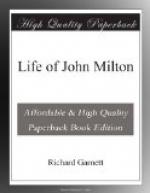It will have been observed that in the contract with Symmons “Paradise Lost” is said to have been “lately licensed to be printed.” The censorship named in “Areopagitica” still prevailed, with the difference that prelates now sat in judgment upon Puritans. The Archbishop gave or refused license through his chaplains, and could not be ignored as Milton had ignored the little Presbyterian Popes; Geneva in his person must repair to Lambeth. Chaplain Tomkyns, who took cognisance of “Paradise Lost,” was fortunately a broad-minded man, disposed to live and let live, though scrupling somewhat when he found “perplexity” and “fear of change” imputed to “monarchs.” His objections were overcome, and on August 20, 1667—three weeks after the death of Cowley, and eight days after Pepys had heard the deceased extolled as the greatest of English poets—John Milton came forth clad as with adamantine mail in the approbation of Thomas Tomkyns. The moment beseemed the event, it was a crisis in English history, when heaven’s “golden scales” for weighing evil against good were hung—
“Betwixt Astrea and the Scorpion sign,”
one weighted with a consuming fleet, the other with a falling minister. The Dutch had just burned the English navy at Chatham; on the other hand, the reign of respectable bigotry was about to pass away with Clarendon. Far less reputable men were to succeed, but men whose laxity of principle at least excluded intolerance. The people were on the move, if not, as Milton would have wished, “a noble and puissant nation rousing herself like a strong man after sleep,” at least a faint and weary nation creeping slowly—Tomkyns and all—towards an era of liberty and reason when Tomkyns’s imprimatur would be accounted Tomkyns’s impertinence.
CHAPTER VII.
The world’s great epics group themselves in two divisions, which may be roughly defined as the natural and the artificial. The spontaneous or self-created epic is a confluence of traditions, reduced to symmetry by the hand of a master. Such are the Iliad, the Odyssey, the great Indian and Persian epics, the Nibelungen Lied. In such instances it may be fairly said that the theme has chosen the poet, rather than the poet the theme. When the epic is a work of reflection, the poet has deliberately selected his subject, and has not, in general, relied so much upon the wealth of pre-existing materials as upon the capabilities of a single circumstance. Such are the epics of Virgil, Camoens, Tasso, Milton; Dante, perhaps, standing alone as the one epic poet (for we cannot rank Ariosto and Spenser in this class) who owes everything but his creed to his own invention. The traditional epic, created by the people and only moulded by the minstrel, is so infinitely the more important for the history of culture, that, since this new field of investigation has become one of paramount interest, the literary epic has been in danger




